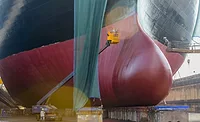Focus On Marine Coatings

This article focuses on two marine coating applications.
Tiny Tubes Making Waves in Kayak Design
Baytubes®, carbon nanotubes from Bayer MaterialScience, are now making waves in kayak design, marking a new chapter in the evolution of these popular boats, which were originally made by the Inuits using wood, bone and animal skin. Today’s kayaks are usually made from plastics and composite materials. Some new kayak prototypes have now been coated with an epoxy gelcoat modified with Baytubes that has been developed by Norwegian research company Re-Turn AS, based in Gamle Fredrikstad. “We are confident that these prototypes outperform standard models in a number of areas,” explains Stein Dietrichson, General Manager of Re-Turn AS.

|
| Click to enlarge |
Reinforcing the outer skin of a kayak, the gel coat with carbon nanotubes makes it far more resilient to abrasion from a shingle beach (beach covered with gravel consisting of large, smooth pebbles unmixed with finer material) or contact with the edge of a river bank. In contrast, many conventional gel coats, especially those of particularly lightweight and sporty kayaks, are highly sensitive to external mechanical action. But that isn’t the only way that these tiny tubes in the solvent-free gel coat help to prolong enjoyment of the boat. They ensure that cracks appear less frequently over long-term use and reduce wear on the outer skin. They also absorb UV radiation, thereby minimizing the associated bleaching and embrittling effects.
Re-Turn AS modified the outer shell of one of the prototypes with Baytubes. “This means that the kayak doesn’t get as dirty above or below the water line and is easier to clean,” states Dietrichson. And he hopes that this innovative combination will result in another effect: “The flow resistance of the hull should also be lower.” This will enable the kayak to glide through the water faster without its occupant having to paddle harder – a fantastic advantage for any aspiring kayaker. And there are further advantages to the use of Baytubes in the epoxy base of the kayak, which the additive helps to make more stable and rigid. “This makes the boat easier to paddle and translates more of the kayaker’s muscle power into speed. The new gelcoat incorporates many advantages from the development of nanotube-reinforced marine paints, which are already commercial,” comments Dietrichson.
Experts from the Norwegian company are already working closely with Bayer MaterialScience to develop further nanotube-reinforced materials that could find their way into the rotor blades for wind turbines. “More and more innovative companies are beginning to recognize that Baytubes have enormous potential to give established materials entirely new properties,” says Dr. Raul Pires, Head of Global Activities for nanotubes and nanotechnology products at Bayer MaterialScience.
For more information, visit www.bayermaterialscience.com, www.baytubes.com and www.re-turn.no.
Coatings for the Historic Battleship Missouri

|
Nearly 5,500 gallons of Sherwin-Williams coatings have been applied to the historic Battleship Missouri, which recently returned to her home pier near the USS Arizona Memorial at Pearl Harbor, Hawaii.
The ex-USS Missouri, or “Mighty Mo,” is known as the site of Japan’s surrender to Allied Forces on September 2, 1945, ending World War II. The ship was launched in June 1944 and provided firepower in the decisive battles for Iwo Jima and Okinawa. On Sept. 2, 1945, the Missouri served as the site of Japan’s formal, unconditional surrender to Allied Powers while anchored in Tokyo Bay, Japan.
The famous ship also saw action in the Korean Conflict and Persian Gulf during Operation Desert Storm. Today, the ship is under the care of the non-profit USS Missouri Memorial Association, which owns and operates the ship as the Battleship Missouri Memorial, a historic attraction and memorial in Pearl Harbor.
Work on the $18 million refurbishment was under the guidance of BAE Systems at the U.S. Navy’s Pearl Harbor Naval Shipyard. The superstructure was pressure washed by memorial volunteers. BAE Systems and its subcontractors used power tools to remove remaining paint, spot-primed bare steel, airless sprayed the ship’s superstructure and freeboard, and plural component-sprayed the underwater hull.
Sherwin-Williams products used on the 887-foot battleship included:
- Dura-Plate® UHS Epoxy, SeaGuard® Vinyl Antifoulant (underwater hull);
- Dura-Plate UHS Epoxy, Polysiloxane XLE-80 (freeboard);
- Macropoxy® 920 Pre-Prime, Mil-PRF-24635 Silicone Alkyd (mast aloft black areas);
- Macropoxy 920 Pre-Prime, SeaGuard 5000 HS Epoxy, Polysiloxane XLE-80 (superstructure); and
- Dura-Plate MT, Dura-Plate UHS Epoxy (decks).
Sherwin-Williams also provided technical expertise and worked closely with both the shipyard and contractor throughout the project. “It was an honor for Sherwin-Williams to provide coatings for one of the most renowned and historically significant ships in U.S. history,” said Brad Rossetto, Vice President Marketing, Sherwin-Williams Protective & Marine.
According to Roger Kubischta, Director of Operations for BAE Systems’ Hawaii Shipyard, “There was a tremendous amount of marine growth stuck to the hull that needed to be removed before the team could start the preservation work. There was corrosion in spots of the hull, but it was mostly intact. In all, over eight acres of the boat’s surface needed to be preserved.”
Dave Herr, President of BAT Systems Support Solutions, said, “BAE Systems was honored to help lead the preservation effort on this historic vessel. With the hard work of our employees and subcontractors, and our trusted partnership with Pearl Harbor Naval Shipyard, one of our nation’s most treasured assets is back pier-side today. We’re grateful for the opportunity to partner with the USS Missouri Memorial Association, whose passion for the project was inspiring and a testament to the historic significance of the Mighty Mo and the importance of bringing her history to life.”
For more information, visit www.sherwin-williams.com.
Looking for a reprint of this article?
From high-res PDFs to custom plaques, order your copy today!







